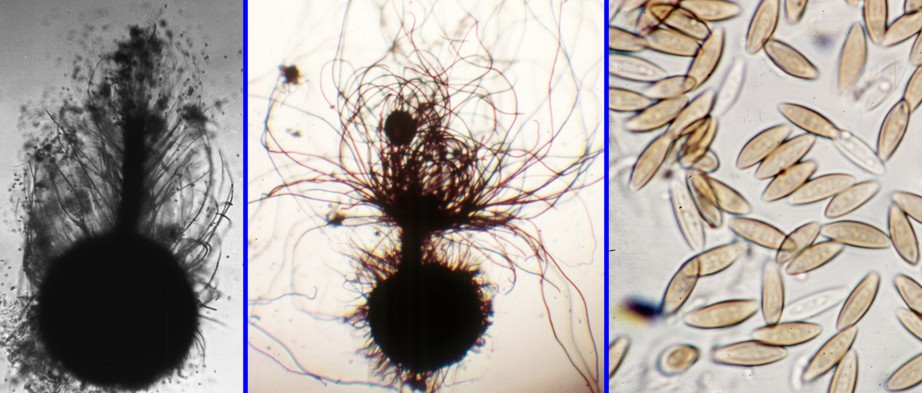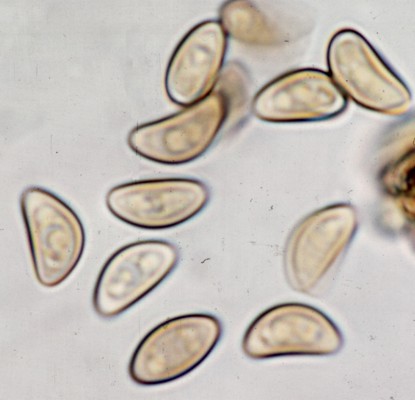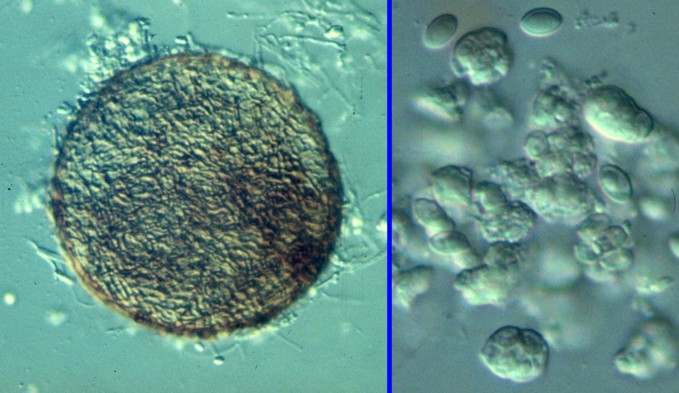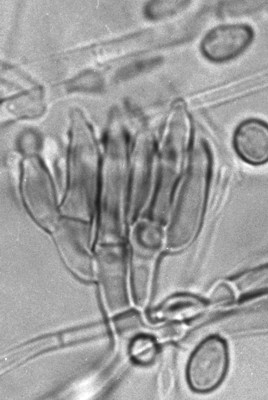Home >> Diversity and classification >> True fungi >> Dikarya >> Ascomycota >> Pyrenomycetes >> Sordariomycetes >> Hypocreomycetidae >> Microascaceae
THE MICROASCACEAE
The Microascaceae are less obviously members of the Hypocreomyctidae than are some of the other families. They have darkly-coloured perithecia and almost brown ascospores. However, dark perithecia are certain known in other members of the subclass and the ascospores of the Microascaceae are not truly brown but really a sort of bright copper colour in mass. All members of the Microascaceae lack asci with forcible spore discharge or with any apical pores or plugs. These asci dissolve when the spores are mature and release them in a mass inside the perithecium or cleistothecium. Ascospores produced in perithecia are pushed up through the ostiole to collect in a mass at its apex. Many species have long necks that elevate the spore mass above the substrate. Cleistothecial species break open as they age and expose the spore mass to the environment.

The pictures above show, left to right, perithecia of Microascus longirostris, Lophotrichus ampullus and ascospores of Petriella musispora. Both of the long-neck perithecia were originally found on dung.
 Petriella musispora was first found on decaying wood where it was associated with the droppings (frass) of insects. Although the ascospores of P. musispora appear to be quite symmetrical many Microascaceae have spores with a marked bilateral symmetry such as those of Petriella guttulata at left. Ascospores of all members of the family are distinctive in being dextrinoid in Melzer's Solution, at least when they are young.
Petriella musispora was first found on decaying wood where it was associated with the droppings (frass) of insects. Although the ascospores of P. musispora appear to be quite symmetrical many Microascaceae have spores with a marked bilateral symmetry such as those of Petriella guttulata at left. Ascospores of all members of the family are distinctive in being dextrinoid in Melzer's Solution, at least when they are young.
Members of the Microascaceae often show a marked affinity for materials of animal origin, such as dung, meat and even living mammalian tissues. They are most often encountered on dung, especially that of rodents and carnivores. The lack of forcible spore discharge excludes them from the usual life history associated with coprophilous (dung-inhabiting) fungi. The production of spore masses suggests the role of insects and other arthropods in their dispersal, but this has yet to be confirmed. Species of the Microascaceae, including their asexual stages, are sometimes isolated from meats kept at low temperatures. This peculiarly bacterial mode of life is seldom associated with fungi. One species, Microascus caviariformis was first found in the Ramioul Cave in Belgium where it had conspicuously colonized a piece of chicken that had fallen from the sandwich of a speleologist who had visited the cave two weeks earlier. This fungus was found to have a strong affinity for proteins and was most successfully grown on Nutrient Agar, a medium usually used only for bacteria. Nutrient Agar contains abundant proteins and amino acids but does not contain glucose. If glucose was added to the Nutrient Agar M. caviariformis was unable to produce perithecia, although it grew well enough.

The affinity of the Microascaceae for animal materials sometimes becomes of medical concern. The fungus at right, Pseudallescheria boydii, is a fairly common inhabitant of manure piles and even rich soil, that can also invade living human tissues. It enters the skin through a puncture wound where it forms relatively harmless mycelial masses called mycetomas. It becomes more serious when it enters an injury to the surface of the eye and begins to grow, becoming severe enough to cause loss of the eye. Persons with compromised immune systems may be especially susceptible to it.

Most Microascaceae have prominant asexual stages belonging to the genera Graphium, Scedosporium, Scopulariopsis and Wardomyces. These anamorphs are frequently encountered without accompanying perithecia or cleistothecia. The photo at left shows the Scopulariosis anamorph of Kernia pachypleura